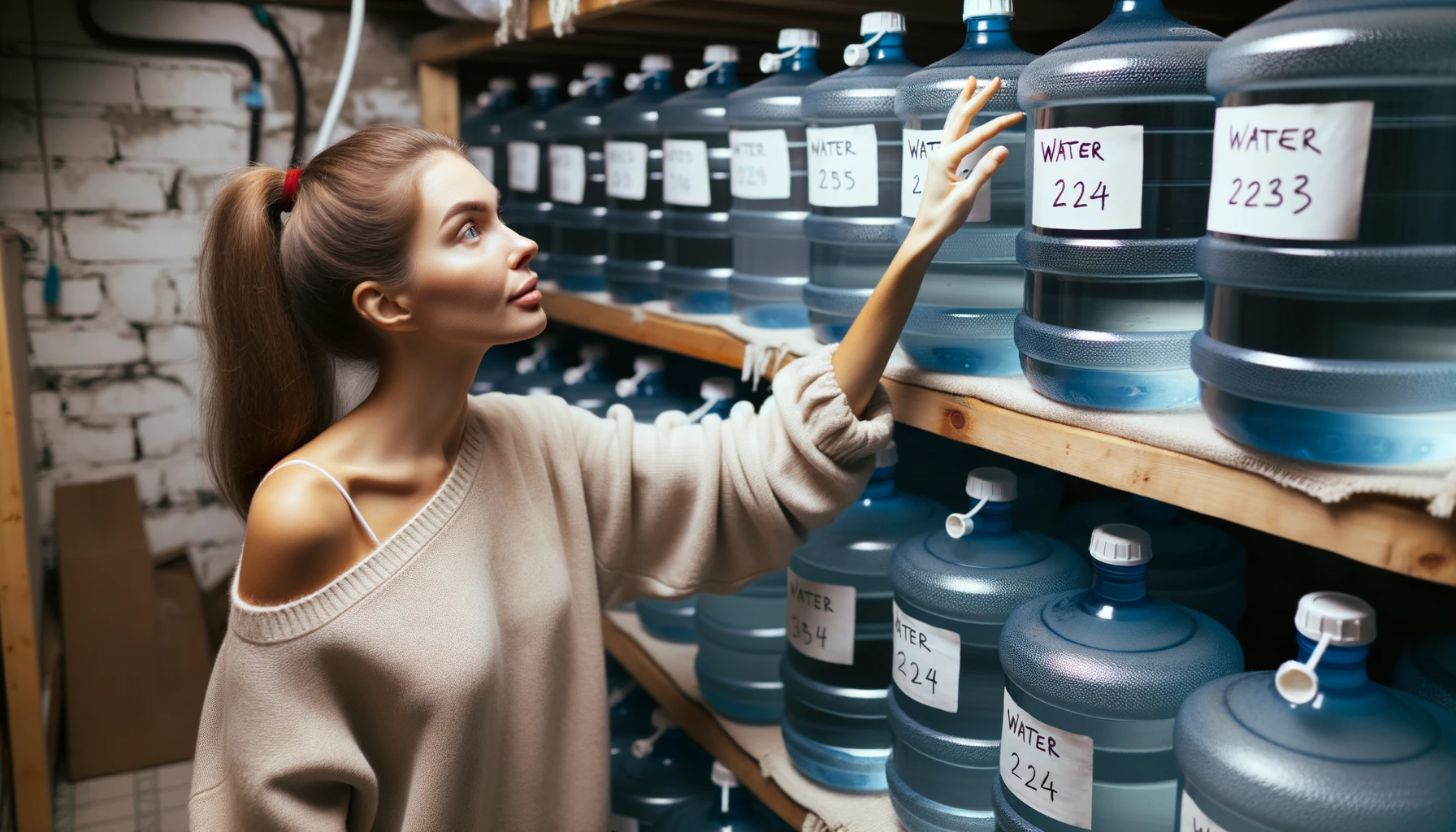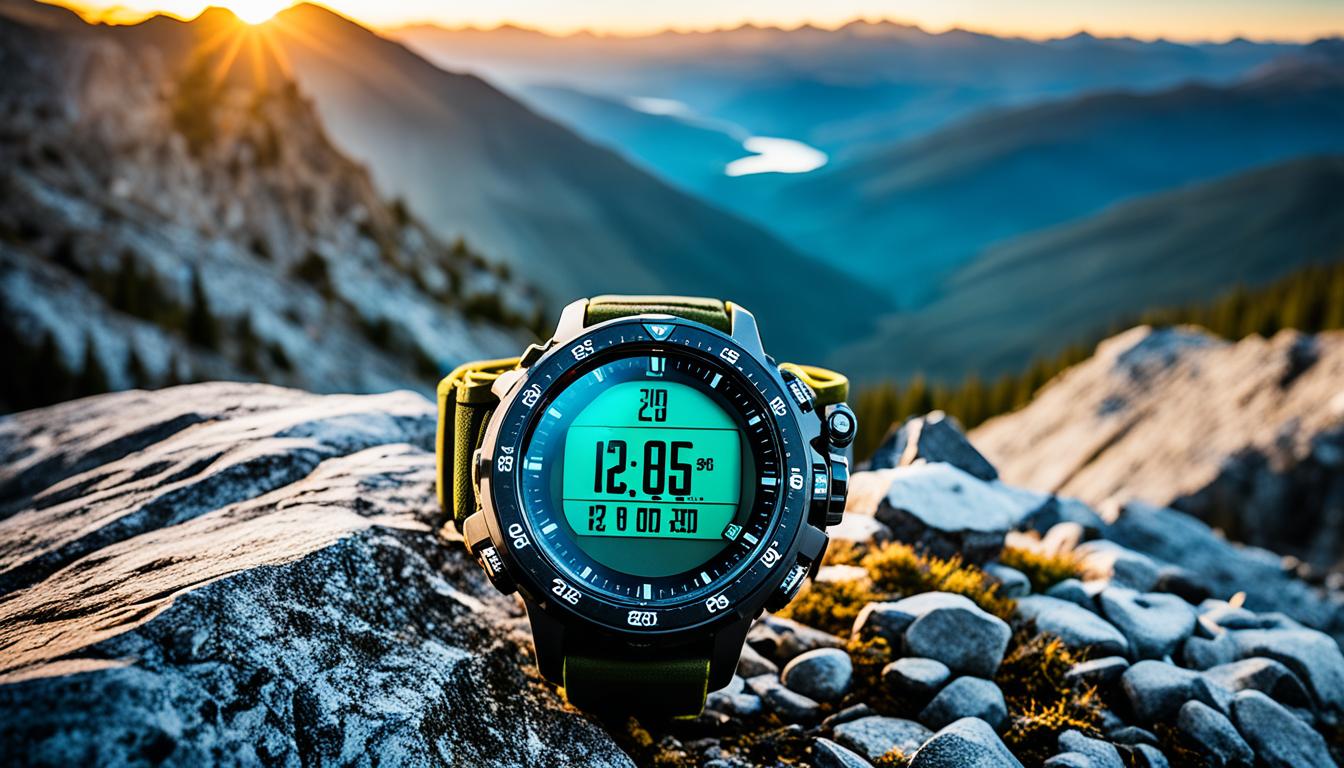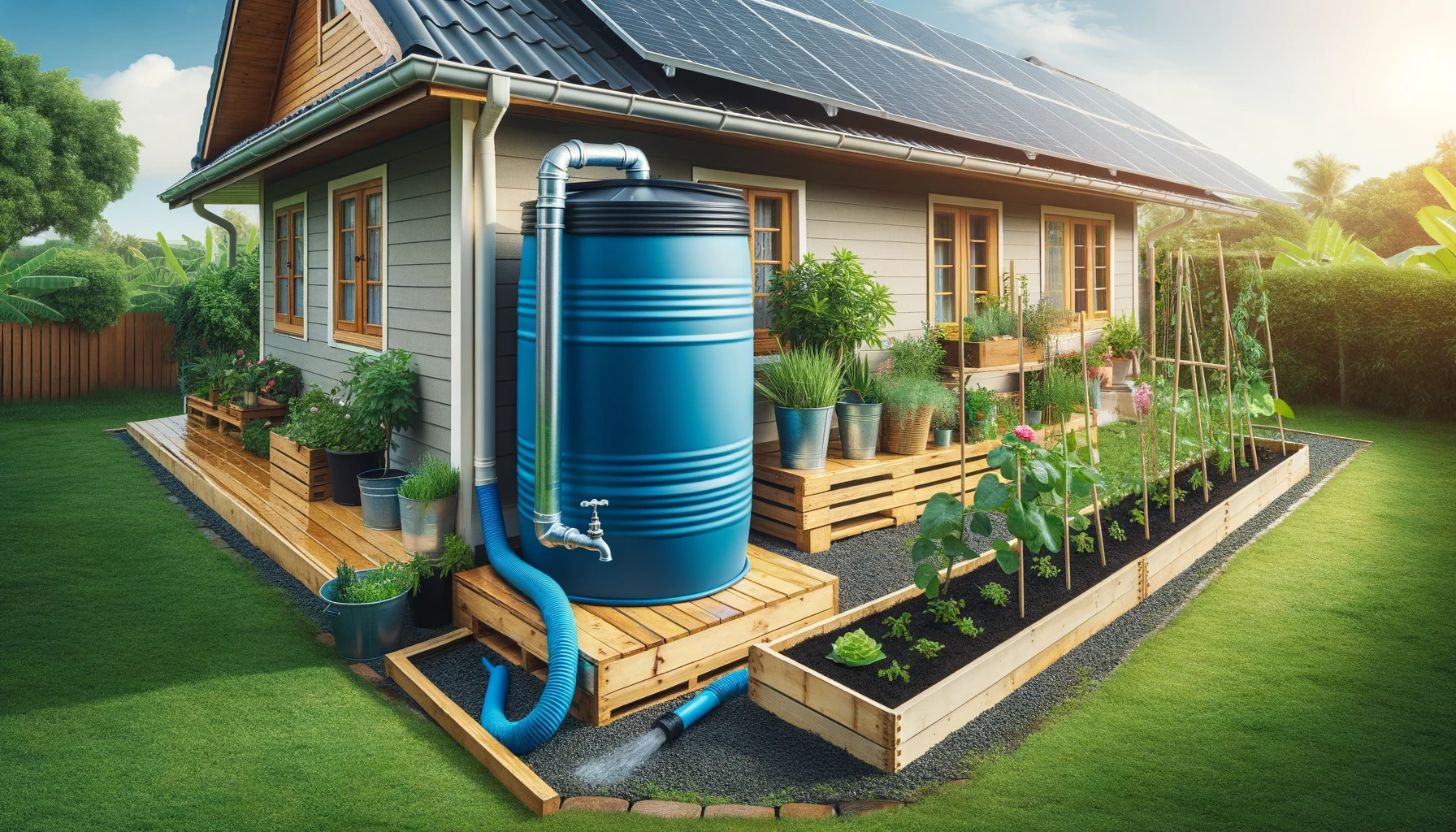Emergencies can happen at any time and being prepared can make all the difference. One of the most crucial steps in emergency preparedness is prepping water storage. Whether you are facing a natural disaster, power outage, or any other type of emergency, having access to safe drinking water is essential. In this comprehensive guide, we will provide you with the essential information on prepping water storage for emergencies.
One of the most important steps in prepping water storage is choosing the right containers. The containers you select must be durable, airtight, and able to store water effectively. Proper water storage maintenance and safety protocols are also crucial to prevent contamination and ensure the availability of potable water. Discover the best practices for storing water in bulk using appropriate containers, including sustainable water storage practices, emergency water filtration and purification, and much more.
Key Takeaways
- Prepping water storage is critical in emergency preparedness.
- Choosing the right containers is vital for efficient storage.
- Proper water storage maintenance and safety protocols are essential to prevent contamination.
- Discover effective methods for storing water in bulk quantities using appropriate containers.
- Explore sustainable water storage practices for long-term water availability and minimal environmental impact.
Importance of Water Storage in Emergency Preparedness
As you prepare for emergencies, it’s essential to consider the availability and quality of water. Having access to safe drinking water is paramount for your survival. While you can go without food for weeks, not having enough water for more than three days can lead to severe dehydration and other life-threatening conditions.
In situations where water supply is cut off or contaminated, having an emergency water storage solution is vital. This is where long-term water storage comes in handy. Storing water for extended periods helps to ensure you have enough water to last throughout the emergency period.
Disclosure: When you buy through links on our site, we may earn an affiliate commission.
Water Storage Solutions
There are different water storage solutions to consider when preparing for emergencies. The best option for you may depend on a variety of factors, including available storage space, your budget, and the duration of the emergency. Some of the common water storage solutions include:
- Water storage containers: These are containers specifically designed for storing water. They come in different shapes and sizes, such as jugs, barrels, or tanks, and can hold varying capacities of water. Water storage containers are ideal for short and long-term storage needs.
- Water storage systems: These are more elaborate solutions that involve installing a water storage system in your home or property. Water storage systems can hold large volumes of water and come equipped with water treatment and filtration systems.
Long-Term Water Storage
When storing water for extended periods, it’s essential to consider the types of containers to use and how to maintain water quality. Some of the factors to consider when prepping for long-term water storage include:
- Container type: Choose a container made of a food-grade material that is resistant to cracks, leaks, and corrosion. Common materials used for water storage containers include high-density polyethylene (HDPE) and polypropylene (PP).
- Water treatment: Over time, stored water can become contaminated with bacteria, algae, and other microorganisms. To keep water safe for consumption, employ a water treatment plan that involves using water purification tablets or adding chlorine bleach to the water.
- Storage location: Store water in a cool, dry place away from direct sunlight and heat sources. Exposure to light and heat can cause water to degrade and develop a foul smell and taste.
By understanding the importance of water storage in emergency preparedness, you can take the necessary steps to ensure you have access to safe drinking water throughout the emergency period. Choose an appropriate water storage solution, and maintain your water storage supplies, containers, and systems to protect your health and well-being.

Choosing the Right Water Storage Containers
When it comes to prepping water storage for emergencies, selecting the right water storage containers is crucial. The wrong containers can lead to contamination and/or leakage, resulting in unsafe water for consumption.
There are various water storage containers to choose from, including plastic jugs, drums, and tanks. When choosing a container, consider its material, size, and functionality.
Types of Water Storage Containers
| Container Type | Features |
|---|---|
| Plastic jugs | Compact, stackable |
| Plastic drums | Durable, larger capacity |
| Water tanks | Most extensive capacity, can be installed outdoors |
Regardless of the container type, make sure it is specifically designed for water storage and is food-grade to avoid any harmful chemicals leaching into your water supply. Consider the container’s emergency application and whether you need it for short-term or long-term storage.
Essential Water Storage Supplies
Having the right water storage supplies is essential for maintaining the quality and safety of your stored water. Some essential supplies include:
- Water treatment tablets or drops: Used to purify contaminated water and make it safe for consumption.
- Siphon hose: Used for transferring water from one container to another or for accessing hard-to-reach areas.
- BPA-free storage bags: Ideal for compact storage and portability.
- Water pump: Used for accessing larger water storage tanks without lifting them.
With the right containers and supplies, you can ensure your water storage is safe and readily available in case of an emergency.
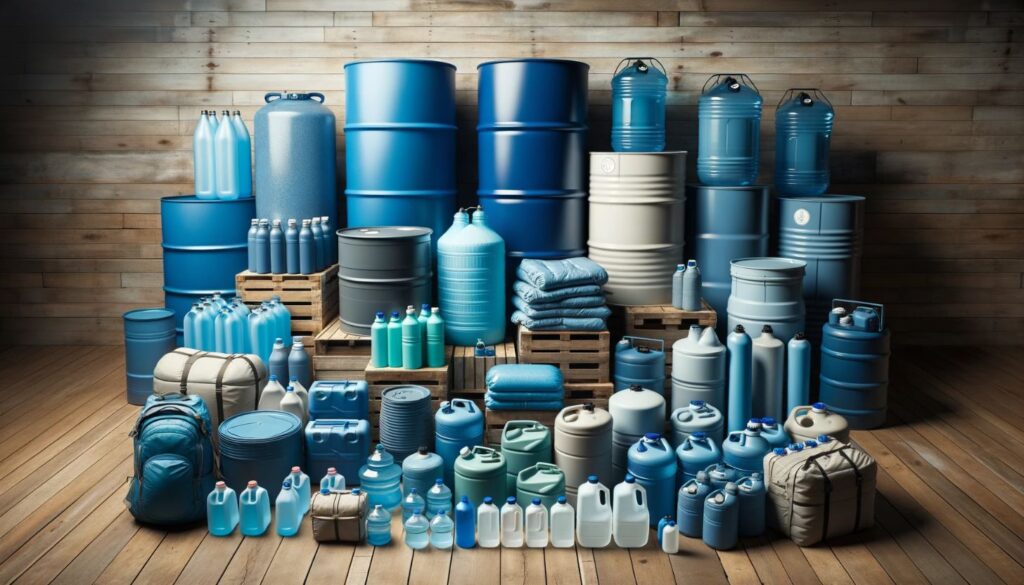
Methods for Storing Water
When prepping for emergencies, it’s essential to know the best methods for storing water efficiently. In this section, we will discuss traditional and alternative methods for storing water, as well as the necessary water storage supplies.
Traditional Methods
One of the oldest methods for storing water is using ceramic or clay pots. These materials are porous, allowing water to evaporate slowly while keeping it cool and fresh. However, ceramic and clay pots can break easily, and they cannot hold more than a few gallons of water.
Another traditional method for storing water is using barrels. Wooden barrels, in particular, are ideal for water storage because they do not leach chemicals. However, wooden barrels can be expensive and challenging to clean, and they require a lot of space.
A third traditional option is using plastic bottles, such as soda bottles. These are easy to find and can be reused for months. However, plastic bottles are not suitable for long-term storage as they can leach chemicals into the water over time.
Alternative Methods
Aside from traditional methods, there are alternative approaches to storing water for emergencies.
One option is using water bags. These collapsible bags can hold up to five gallons of water, and they are portable and easy to store. However, water bags are not as durable as other containers, and they can puncture easily.
Another alternative method is using metal water cans. These are durable and can hold more water than ceramic or plastic containers. However, metal cans can rust over time and may require special maintenance.
Necessary Water Storage Supplies
Regardless of the storage method you choose, there are some essential water storage supplies you should have on hand.
Water purification tablets or drops are necessary to treat water before consumption. These can eliminate viruses, bacteria, and other harmful contaminants.
A siphon or pump is also essential for transferring water between containers, especially for larger containers like barrels.
Lastly, a water filter or purifier is necessary for long-term storage. These devices can remove impurities and improve the taste of stored water.
By following these methods and using the necessary supplies, you can store water effectively and ensure your survival during emergencies.
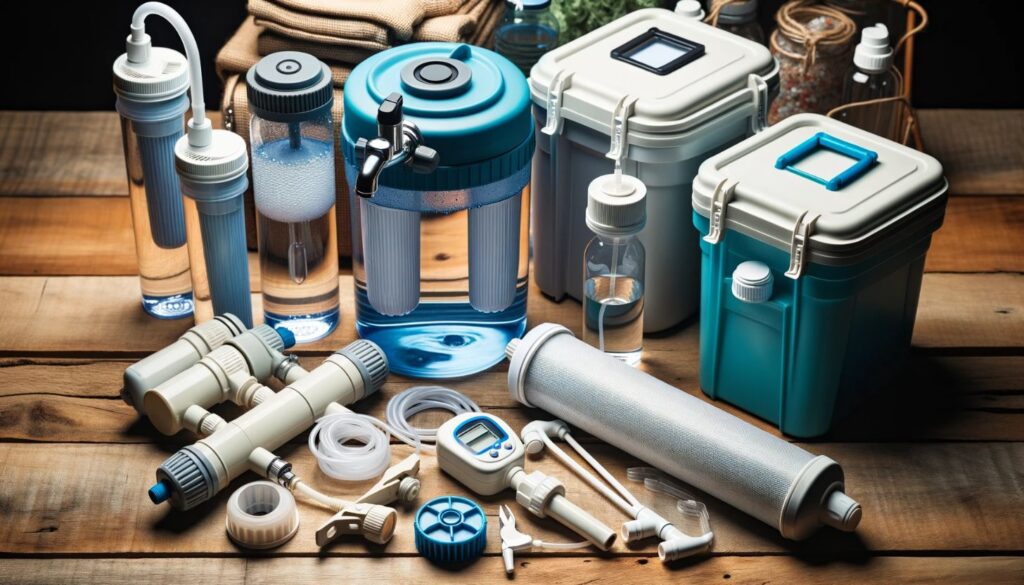
Long-Term Water Storage Solutions
When it comes to prepping water storage for emergencies, ensuring long-term water availability is crucial. Whether you’re preparing for a natural disaster, a power outage, or any other emergency, having a sufficient supply of water can mean the difference between life and death. In this section, we will explore different long-term water storage solutions, including the use of specialized water storage containers and systems.
Specialized Water Storage Containers
Choosing the right water storage containers for long-term storage is essential. You need to consider several factors, such as durability, size, and ease of use, among others. Some of the most popular water storage containers include:
| Container Type | Capacity | Pros | Cons |
|---|---|---|---|
| Plastic Barrels | 15-55 gallons | Relatively cheap and easy to find, lightweight, and portable | May leach chemicals into the water after prolonged storage |
| Water Bricks | 3.5 gallons each | Durable, stackable, and easy to transport | Expensive compared to other container types |
| Large Water Tanks | 100-500 gallons | Can store a significant amount of water, usually made of durable materials | Not portable, expensive, and may require installation or a dedicated space for storage |
The size and type of container you choose will depend on your specific needs and circumstances. Make sure to select a container that is airtight and can keep the water free of contaminants.
Water Storage Systems
Water storage systems are a more sophisticated solution for long-term water storage. These systems can store water for extended periods and provide added convenience, such as filtering and pumping mechanisms. Some of the most popular water storage systems include:
- Water Storage Tanks: These tanks can store hundreds or thousands of gallons of water and come in various materials, such as plastic, steel, or concrete. They are durable and relatively easy to install.
- Rainwater Harvesting Systems: These systems collect and store rainwater from your roof or other surfaces. They can provide a sustainable source of water, but the quality of the water may be questionable, and the system can be expensive.
- Well Water Storage Systems: If you have a well on your property, you can install a well water storage system to store water for emergencies. These systems pump water from the well and store it in a tank. However, they can be costly and require professional installation.
Whichever water storage system you choose, make sure to maintain it regularly and keep it clean to ensure the water remains safe to drink.
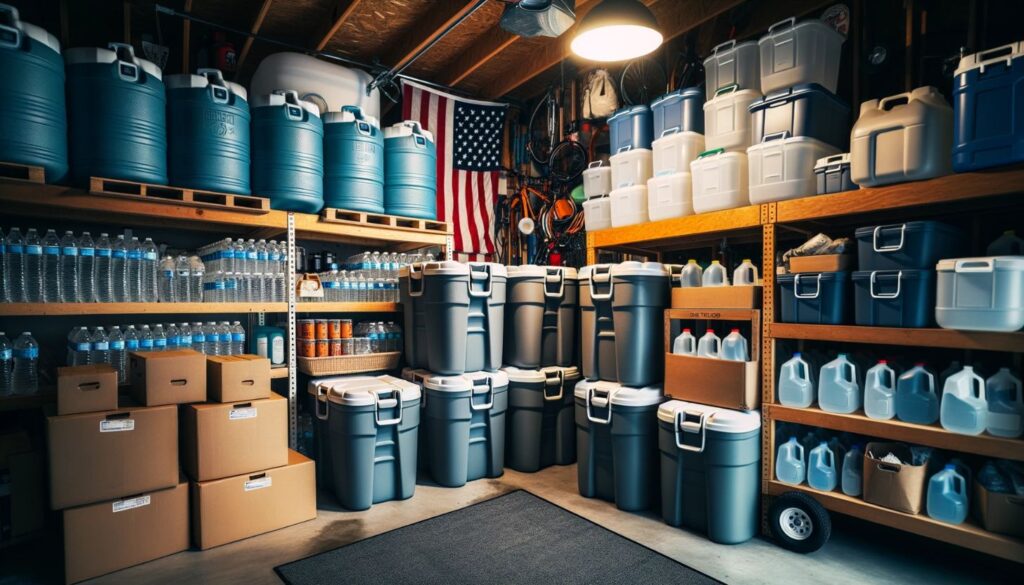
In conclusion, long-term water storage is an essential aspect of emergency preparedness. With the right water storage containers and systems, you can ensure that you and your family have access to clean and potable water for extended periods. Choose a solution that fits your needs and circumstances, and remember to maintain and regularly inspect your water storage supplies to ensure their safety and usability.
Water Storage Maintenance and Safety
Proper water storage maintenance and safety protocols are essential to prevent contamination and ensure the availability of potable water. By following these best practices, you can maintain the quality of your water storage supplies, containers, and systems:
Regular Cleaning
Regularly clean your water storage containers, including the inside and outside surfaces, to remove any buildup of bacteria, dirt, or debris. You can use a bleach solution or other approved water storage disinfectants to clean the containers. Rinse the containers with clean water and allow them to dry before refilling them.
Monitoring Water Quality
Test your stored water regularly to ensure it remains potable. Invest in a water quality test kit to check the pH level, chlorine and fluoride content, and other parameters of the stored water. If you detect any changes in the quality of the water, take immediate remedial action to prevent contamination.
Replacing Water Regularly
Over time, even properly stored water can become stale and unsuitable for drinking. Therefore, it’s essential to rotate your water storage supplies regularly by emptying and refilling containers with fresh water. A standard practice is to replace the stored water every six months to one year, depending on the storage conditions and the type of containers used.
Securing the Storage Area
Avoid storing water containers near chemicals, pesticides, or other hazardous substances. Keep the storage area clean and dry, and away from direct sunlight to prevent algae growth. If storing water outside, ensure that the containers are covered and protected from the weather.
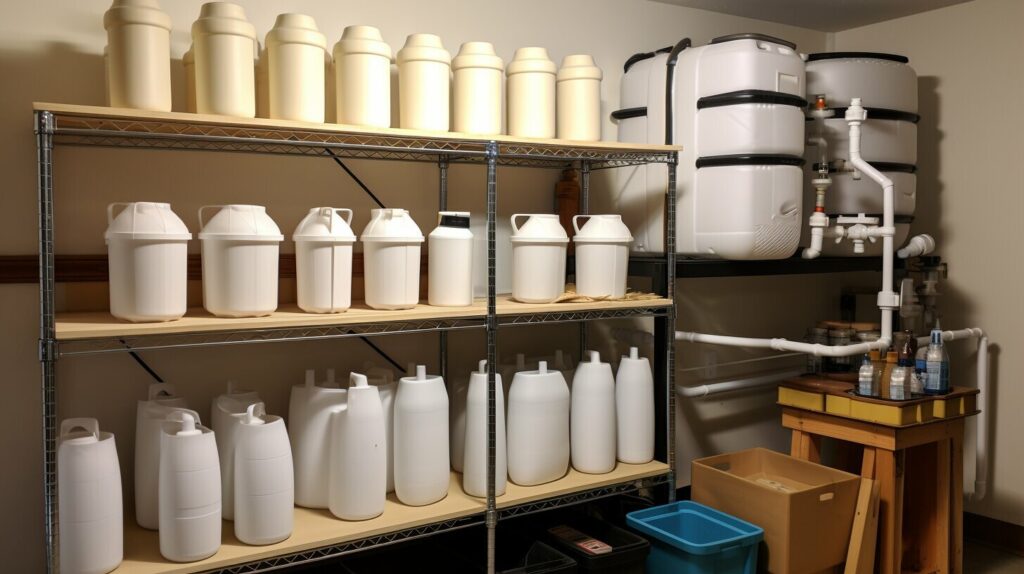
“Regular cleaning, monitoring water quality, replacing water regularly, and securing the storage area are vital to prevent water contamination and ensure the availability of potable water.”
Emergency Water Filtration and Purification
When faced with an emergency situation, access to safe and potable water is essential for survival. Unfortunately, natural disasters or other emergencies can disrupt the water supply, leaving you without a reliable source of water. In such situations, it may be necessary to filter or purify water for consumption. That’s where emergency water filtration and purification comes in.
There are various methods of emergency water filtration and purification available, ranging from simple and affordable options to complex and expensive systems. Here are a few common methods:
- Boiling: One of the most straightforward methods of water purification is boiling. Boiling water for at least one minute can kill most bacteria and viruses that may be present. However, boiling does not remove chemical or mineral contaminants.
- Chemical Water Treatment: Chemical treatments such as iodine or chlorine can be used to purify water. Be cautious with chemical treatments, as they can be harmful when ingested in large quantities or over a prolonged period. It is advisable to follow the instructions carefully and use pre-packaged water treatment drops or tablets.
- Portable Water Filters: Portable water filters are an effective way to filter out impurities from water. These filters are small, lightweight, and easy to carry, making them ideal for emergency situations. Typically, the filters use a combination of physical and chemical filtration to remove contaminants.
- UV Water Purifiers: UV water purifiers use ultraviolet light to kill bacteria and viruses present in water. While this method is highly effective, it requires a power source and specialized equipment, making it less practical for emergency situations.
When prepping for emergency water storage, it is essential to consider obtaining the necessary water storage supplies, including filtration and purification systems. Portable water filters, such as the Lifestraw, are an affordable and effective way to ensure clean and safe drinking water in emergency situations.
Remember that even with the best filtration and purification methods, it is essential to store water properly to prevent contamination. Monitor your water storage containers regularly and sanitize them as necessary.
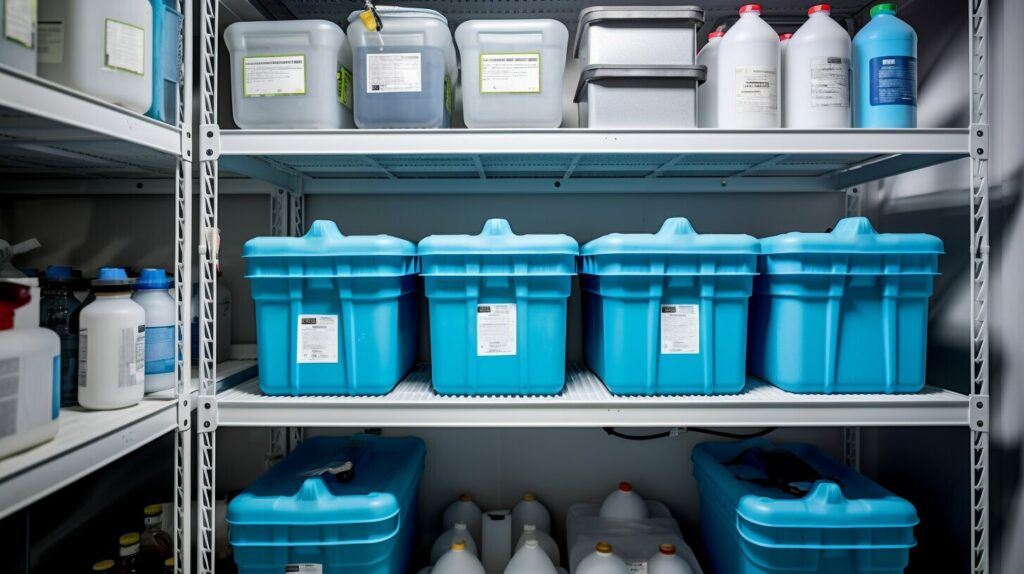
Storing Water in Bulk
When prepping water storage for emergencies, it’s essential to consider storing water in bulk. Bulk water storage refers to keeping a large amount of water on hand, enough to last for an extended period. This approach is particularly useful for long-term water storage in disasters such as hurricanes, floods, or earthquakes.
The advantages of storing water in bulk include:
- Reducing the need to find water sources frequently.
- Ensuring adequate water supply during prolonged emergencies.
- Providing water reserves for community use in case of larger emergencies.
When choosing the containers for bulk water storage, consider several factors. The first and foremost criteria are durability and strength to withstand the weight of the stored water. Secondly, select containers that are food-grade, meaning they have not been used to store chemicals and are safe for human consumption. Lastly, the design of the container must prevent light from penetrating the water, as sunlight can cause bacteria and mold to grow in the water.
Once you have selected the appropriate container, you must store it correctly. Always place the container on a flat and stable surface that can support the weight of the water. Store the container in a cool, dark place to prevent light from penetrating the container and causing bacteria and mold growth in the water.
Storing water in bulk is an efficient and practical approach for long-term water storage during emergencies. By selecting suitable containers and following the right storage practices, you can ensure that you and your loved ones have access to safe and potable water in times of crisis.
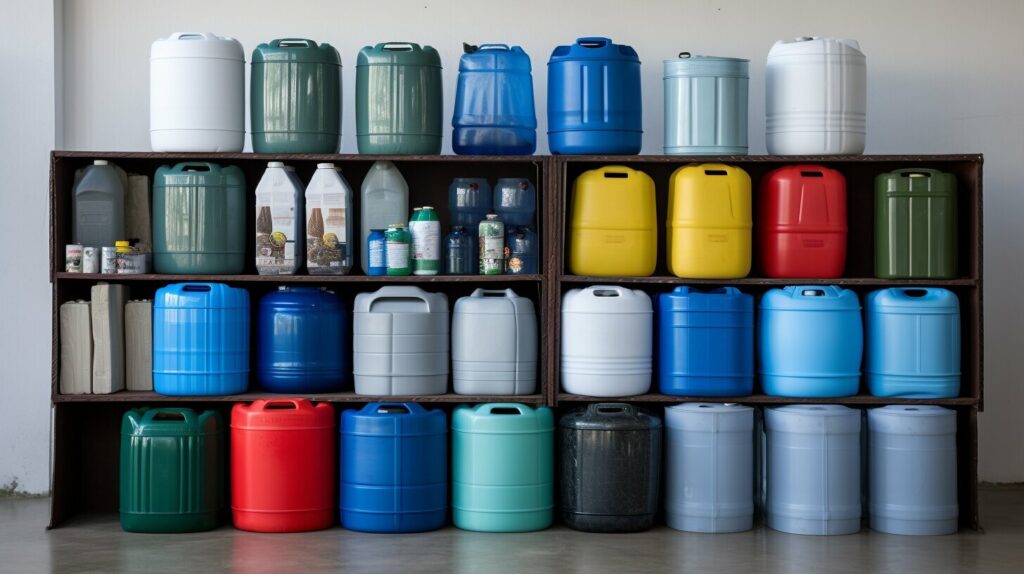
Water Storage for Different Environments
When prepping for emergency water storage, it’s crucial to consider the specific environment you’re in. Different regions have unique water storage requirements, and your preparations should reflect those needs.
If you live in an urban area, your primary concern may be storing enough water for a short-term emergency, such as a power outage or natural disaster. In this case, a water storage solution that can hold at least three days’ worth of water per person is recommended.
On the other hand, if you live in a rural area, your water storage needs may be more complex. Long-term water storage may be necessary, especially if you rely on a well for your water supply. In addition, rural areas may be more prone to natural disasters, such as floods or wildfires, which can disrupt the water supply.
If you live in an area with high humidity or frequent rainfall, you may have more options for emergency water storage. Collecting rainwater in barrels or other containers can be a sustainable solution for short-term emergencies. However, it’s crucial to properly filter and sanitize collected rainwater before consumption.
Regardless of your location, having a reliable emergency water storage solution is crucial. Make sure to regularly check and maintain your water storage containers and supplies to ensure the water remains safe to consume.
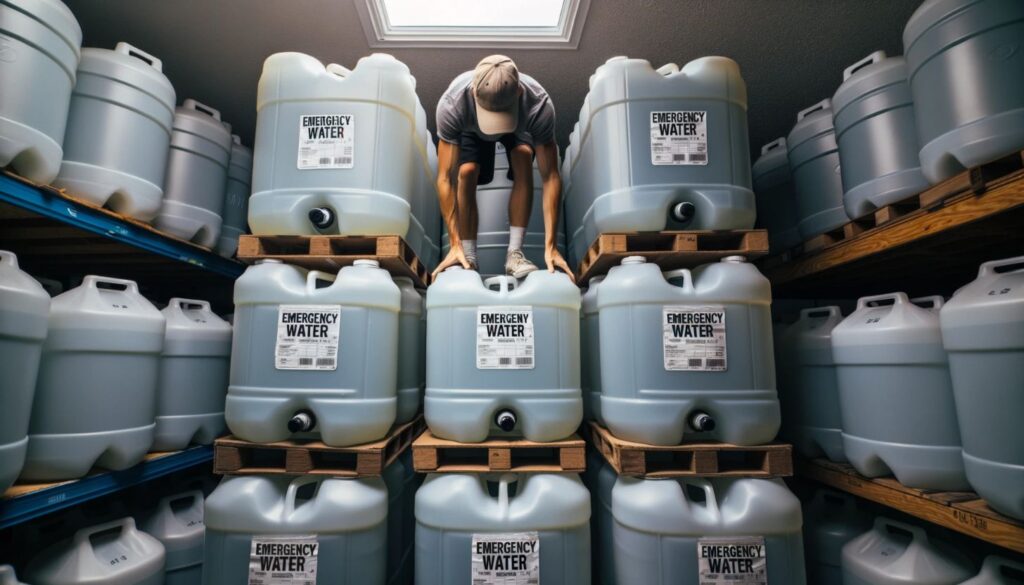
Remember, in an emergency, water is one of the most vital resources you’ll need to stay alive. Take the time to evaluate your environment and prepare accordingly to ensure you have the water you need to make it through any crisis.
Water Storage for Specific Emergencies
Prepping your water storage for emergencies is crucial, but different scenarios may require specific considerations. Here are some essential tips for water storage during particular emergencies:
Natural Disasters
Natural disasters such as hurricanes, floods, and earthquakes may disrupt water supplies, making emergency water storage necessary. It is recommended to store at least one gallon of water per person per day for three days for drinking and other essential purposes.
Use water storage containers that are appropriate for your household size and easily transportable if evacuation is necessary. It is advisable to label your containers with the date and type of water stored, to ensure safe consumption, and regularly check and rotate stored water to maintain its freshness.
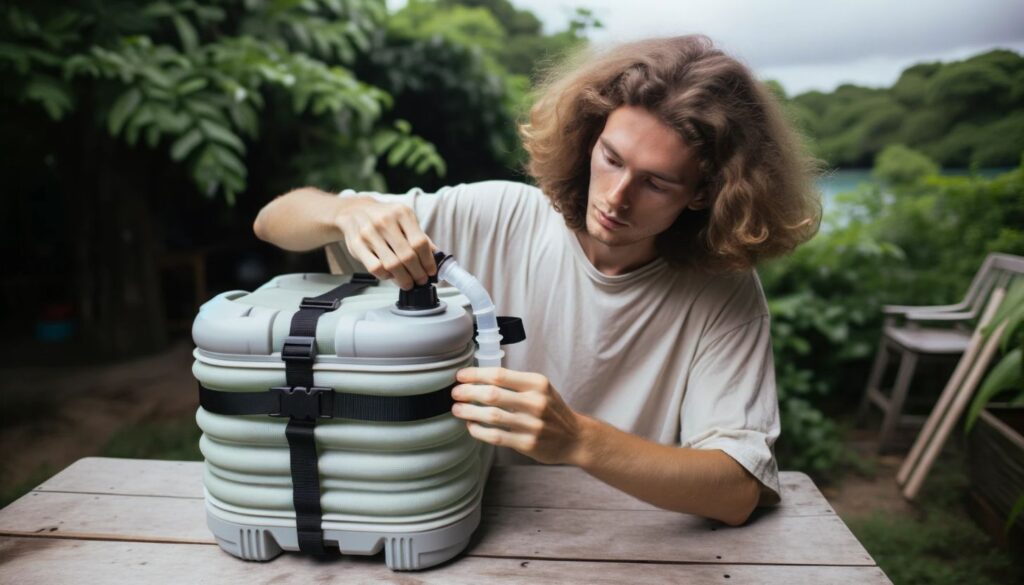
Prolonged Power Outages
Power outages may impact water filtration and purification systems, making emergency water storage necessary. It is recommended to store at least one gallon of water per person per day for a minimum of three days, or up to two weeks for an extended outage.
Store water in safe, airtight containers in a cool, dark place away from direct sunlight. It is essential to have water storage supplies, including a manual pump, purification tablets, or a portable filtration system, for treating stored water as needed.
Urban Emergencies
Urban emergencies, such as chemical spills or terrorist attacks, may require sheltering in place or immediate evacuation. In these scenarios, it is recommended to store at least three days of water per person, as local water supplies may be contaminated.
Choose water storage containers that are durable, portable, and easy to store in small spaces. Consider the storage location carefully, ensuring it is easily accessible in an emergency but also secure and protected from potential contamination.
Rural Emergencies
Rural emergencies, such as a drought or wildfire, may require long-term water storage solutions for extended periods. In this scenario, it is recommended to store at least two weeks of water for each person in your household.
Use specialized water storage containers or systems, such as underground cisterns or rainwater catchment systems, to collect and store water. It is essential to have the necessary water storage supplies and access to reliable water sources, such as wells or springs, to maintain your stored water supply.
By prepping your water storage for specific emergencies, you can ensure you and your family have a safe and reliable supply of potable water during challenging situations.
Sustainable Water Storage Practices
When it comes to prepping water storage for emergencies, sustainability is an important factor to consider. By incorporating eco-friendly practices and materials into your water storage system, you not only ensure long-term water availability but also minimize your environmental impact.
Use of Recycled Water Storage Containers
One sustainable option for water storage containers is the use of recycled materials. Look for containers made from recycled plastic, which not only keeps plastic waste out of landfills but also reduces the need for new plastic production.
Incorporating Rainwater Harvesting Systems
Rainwater harvesting systems are an excellent way to supplement your water storage supply, especially in areas with frequent rainfall. These systems collect rainwater and store it in tanks or cisterns for later use. With the right filtration and purification methods, rainwater can be a safe and sustainable source of drinking water.
Implementing Solar-Powered Water Pumping Systems
Traditional water pumping systems require electricity or fuel to function, making them unsustainable in prolonged emergency situations. Consider implementing a solar-powered water pumping system, which uses renewable energy to pump water from a well or other water source into your storage containers or system.
Use of Biodegradable Water Storage Bags
For short-term emergency situations, consider using biodegradable water storage bags instead of plastic water bottles or containers. These bags are made from plant-based materials and break down naturally over time, unlike traditional plastic containers that can take hundreds of years to decompose.
Proper Maintenance and Repair of Water Storage Systems
Maintaining and repairing your water storage systems is essential to prevent leaks and other issues that can lead to water waste. By fixing leaks promptly and ensuring proper insulation and protection of your containers, you can extend their lifespan and reduce the need for new replacements.
By incorporating these sustainable water storage practices, you can ensure your water supply is not only reliable and safe but also environmentally friendly. Choose materials and systems that minimize your impact on the planet while still meeting your emergency preparedness needs.
FAQ
What is the importance of water storage in emergency preparedness?
Water storage in emergency preparedness is crucial as it ensures a reliable source of clean water during times of crisis. In emergencies, access to safe drinking water may be compromised, making stored water essential for survival.
How do I choose the right water storage containers?
When selecting water storage containers, consider factors such as capacity, durability, ease of use, and portability. Look for containers that are food-grade and specifically designed for long-term water storage.
What are the different methods for storing water?
There are various methods for storing water, including using water barrels, tanks, large jugs, or even repurposed containers like clean soda bottles. It’s important to choose a method that suits your needs and ensures water safety.
How can I ensure long-term water storage?
Long-term water storage can be achieved by properly sealing containers, using water preservatives or treatments to prevent bacterial growth, and regularly rotating stored water to maintain freshness.
How do I maintain and ensure the safety of my water storage?
To maintain water storage, regularly inspect containers for leaks or damage, clean them with mild soap and water, and sanitize them using bleach or other approved water disinfectants. It’s crucial to follow recommended safety protocols to avoid contamination.
What are the options for emergency water filtration and purification?
In emergencies, water filtration and purification methods such as boiling, using commercial water filters, or using water purification tablets can be effective. Keep these emergency water storage supplies handy for such situations.
What are the benefits of storing water in bulk?
Storing water in bulk quantities ensures that you have an ample supply for prolonged emergencies. Bulk storage containers, such as large water tanks or barrels, are cost-effective and can provide peace of mind during extended periods without access to clean water.
What should I consider when prepping water storage for different environments?
Factors to consider when prepping water storage for different environments include the availability of water sources, the climate, the duration of emergencies typically experienced, and any specific challenges posed by the environment, such as extreme temperatures or natural disasters.
How do I ensure sustainable water storage practices?
To ensure sustainable water storage practices, consider using eco-friendly water storage containers made from recycled materials, implementing rainwater harvesting systems, and incorporating water treatment systems that minimize water waste and environmental impact.
Are there specific considerations for water storage in different emergencies?
Yes, different emergencies may require specific considerations for water storage. For example, during natural disasters, it’s important to have a sufficient supply of water stored in advance, while power outages may necessitate alternative methods for accessing and storing water.

